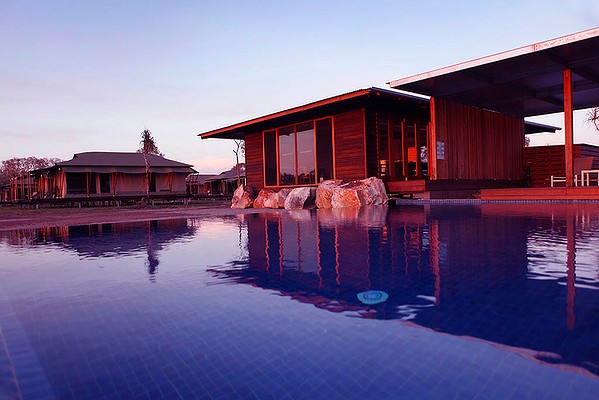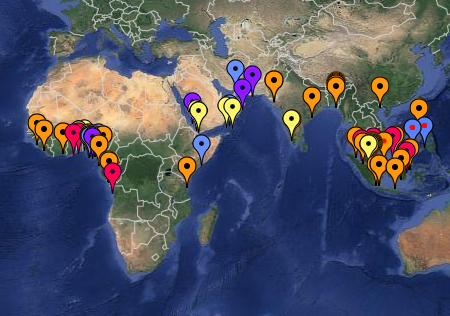Australia – Northern Territory
An agile wallaby is one of the cutest marsupials you’re likely to see. These little bounders with wide-open eyes and a curious gaze are gathering around my verandah as I try to sleep. The frogs are croaking and the dingoes are baying.

Wildman Wilderness Lodge, 170 km from Darwin, provides a collection of luxury African-style tents and cabins on the edge of the Mary River wetlands
This is Wildman Wilderness Lodge, a collection of luxury African-style tents and cabins with a central lodge and infinity swimming pool that has opened recently on the edge of the Mary River wetlands between Darwin and Kakadu National Park.
In the wetlands, irritable buffalo and pigs are wallowing in the mud. These feral beasts are in the cross-hairs of a shoot-to-kill eradication program aimed at protecting this 8000-square-kilometre flood plain. They trample among lily pads in ankle-deep water that has the largest concentration of crocodiles in Australia and teems with jabiru, magpie geese and loud, screeching black cockatoos.
One of the crocs here is a five-metre salty named Big Arse, who might be aged 40 years to 60 years and lives in Wildman’s home billabong. Just in case you don’t see him during a resort boat cruise, he is captured in a photo hanging in the main lodge.
I have my tent zipped up tight, not to keep out these wild things but as protection from the mosquitoes, which leave bites like sherbet bombs of itchiness, ready to explode when touched.
Wildman’s tents have polished blackbutt floors, king-size beds loaded with soft pillows and ceiling fans over the beds to stir the hot air. The tents have chic corrugated-tin bathrooms and flushing toilets and each has a writing desk, a mini bar and verandah chairs. Each tent costs about $100,000 to assemble and is finely finished and draped in the best African canvas. They are also equipped with a “survival kit” that includes a wind-up torch, hairdryer, sunscreen and insect repellent, but this is where my troubles start.
I’m too slow to apply the Wildman-issued Aeroguard during an afternoon bush amble with indigenous guide Neddy Tambling and the mosquito bites are now driving me crazy as I lie under the ceiling fan, listening to the creatures and eyeballing the agile wallabies under the outback stars.
During the walk, Tambling takes us to the soggy edges of the wetlands where termite fields, pandanus and paperbark give way to near impenetrable pools, channels, billabongs and rivers. Tambling has us tasting rosella flowers and smelling eucalyptus plants used as bush medicine. He shows us trees used for making spears and tells of hunting file snakes and turtles. He keeps an eye out for crocodiles and, half-jokingly, advises: “Run for a tree if you see a buffalo.” On a routine day, Tambling sees more buffalo than people. “I went to the footy in Melbourne last year to watch my nephew [Richard Tambling] play and I’d never seen so many people together in one place,” he says.
Walking to the edges isn’t the only way to explore the wetlands. We also hop in a helicopter and take a scenic flight, scooting low across the water as buffalo and pigs scurry off. Our pilot, Phil O’Driscoll, tells of catching a crocodile recently to relocate it somewhere safer (safer for people, I guess). “We were dragging it up the river bank with a rope but it was so muddy, we were all slipping down towards it,” he says. “We finally tied the rope to a bullbar on the four-wheel-drive and pulled it out that way.”
Crocodile stories are all around. O’Driscoll drops us in the wetlands at a waiting airboat driven by Robert Townsend. There’s mud between our toes as we scramble aboard for a joy ride, powered by a Chevy V8 that drives a big aeroplane-like propeller at the rear. As we skim across the water’s surface at high speed, small freshwater crocodiles thrash out of the way. The big saltwater crocodiles keep their cool and submerge, leaving only a trace of bubbles. We come across some horses on high ground and Townsend tells of mustering a stranded herd of eight last season with the airboat when a crocodile attacked. “They were swimming in a tight pack and the croc jumped on the back of four of them and started to bite into them but it was too small to take them down. I spent the next few days stitching up horses.”
The helicopter and airboats are in the repertoire of activities at Wildman, owned by Indigenous Business Australia and managed by tourism entrepreneur Grant Hunt, whose Anthology group also has Wilpena Pound Resort, Cradle Mountain Huts and Bay of Fires Lodge.
At a more gentle pace than the chopper and airboat, Wildman’s executive chef, Aaron Lee, provides cooking demonstrations over the outdoor fire-pit, where he cooks butter scallops and baby ocean trout with lemon myrtle, rosemary and lime.
“I’ve wrapped the fish in foil today but if we were out camping [real camping, without luxury tents, I presume], then I’d use paperbark,” he says. The open fire is a focus at the lodge and is surrounded by wraparound, sofa-style seating perfect for sunset with drinks.
To the right of us are the tents and to the left are cabins called “habitats”. They have been relocated from the defunct luxury Wrotham Park Station, 2800 kilometres away in Queensland, and provide air conditioned comfort.
As we watch the sun dip and the frogs and cicadas start their cacophony, the mosquito activity increases and I know it’s time to move inside.
Location (12° 31′ 40″ S, 131° 34′ 0″ E)
Qantas and Jetstar fly to Darwin from Sydney (4hr 30min). Jetstar and Virgin Australia fly from Melbourne (4hr 15min).
Wildman Wilderness Lodge is about 170 kilometres from Darwin via the Arnhem Highway and Point Stuart Road. The resort provides road or helicopter transfers.
Wildman Wilderness Lodge is open between March and November. It has 15 African-style safari tents and 10 “habitat” cabins.
View Northern Territory in a larger map


